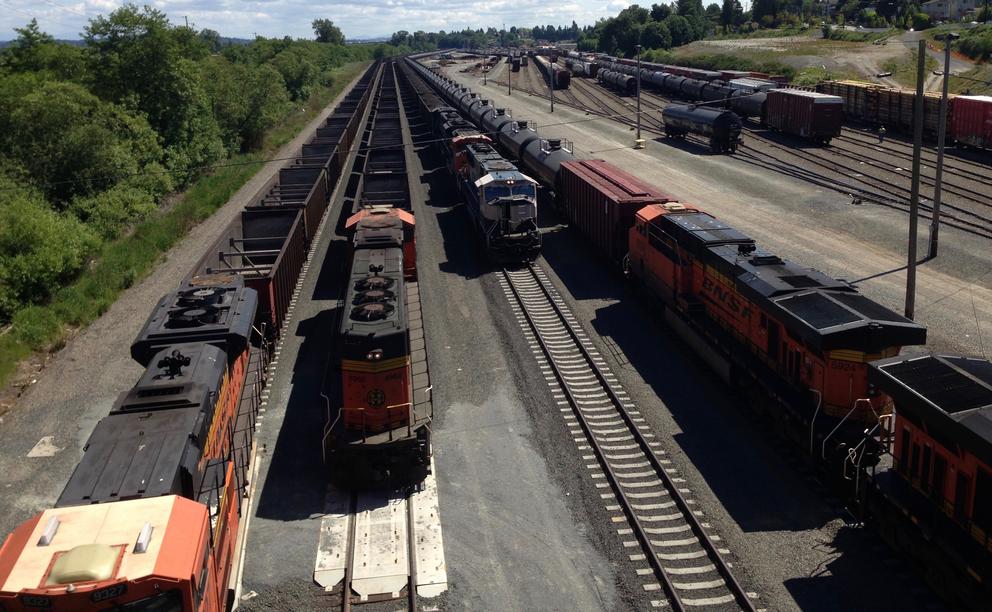Those dominoes just keep falling.
Not so long ago, it seemed as if every time you turned around, somebody new was proposing to ship fossil fuels through the Pacific Northwest. The Salish Sea and the Columbia River were going to become greenhouse gas central. Now, a lot of those proposals have floundered and others look less plausible. Last month, Oregon LNG abandoned its effort to build a liquefied natural gas export facility at the mouth of the Columbia River. Four days later, Northwest Innovation Works scrapped its lease for a site to build a methanol plant at the port of Tacoma.
Meanwhile, American coal companies have been plunging into bankruptcy. An estimated one-quarter of the industry has gone off a cliff. In January, Arch Coal, the nation's second-largest coal company — which owns 38 percent of the proposed Millennium Bulk Terminals coal export facility at Longview — filed for bankruptcy. In April, the nation's largest coal company, Peabody Energy — which is expected to provide 51 percent of the coal that would be shipped through the planned Gateway Pacific Terminal at Cherry Point — followed suit.
Major fossil fuel export projects are still on the table. Gateway Pacific and Millennium are still under review, the Tesoro Savage plans for an oil shipping facility at the Port of Vancouver, has gotten a lease extension. Two methanol plants are planned along the Columbia River. Two oil pipelines and a coal port expansion are still being considered in British Columbia.
But do any of them still make economic sense? Some critics have long doubted it. As the Vancouver Columbian reported, some analysts still see good sense, for instance, in the Tesoro Corporation and Savage Companies' plans for a terminal in Vancouver but even among them, there is some caution about full development of an oil terminal there in the short term.
A draft environmental impact statement for the Millennium project came out April 29, noting that Millennium "states further development of western U.S. coalfields and the growth of Asian market demand for U.S. coal is expected to continue." No doubt that was truly the expectation in 2010 when the project received its first permit. But now? The past tense seems more appropriate.
"Coal's a dead man walking," says Clark Williams-Derry of the Sightline Institute, which opposes the coal projects. He talks about “zombie proposals.”
"There's no way you can get U.S. coal off the coast at anything approaching a profit," he says.
Environmentalists have predicted coal’s demise before, only to see it rise again when the cost of other fossil fuels gets high enough to make it economically attractive again. But this time may be different. "The recent bankruptcies of the nation’s leading coal producers are the latest benchmark in the steady decline of the coal industry," Tom Sanzillo and David Schlissel of the Institute for Energy Economics and Financial Analysis wrote recently in a New York Times op-ed.
"The U.S. economy has experienced a slow, modest recovery at the same time the coal industry has collapsed," explains Tom Sanzillo. "This decoupling is historically unprecedented."
What happened? A lot. The price of natural gas plummeted, making coal a higher-priced alternative — as well as dirtier and less climate-friendly. Regulations meant to reduce conventional pollution and more recently greenhouse gas emissions have imposed costs and uncertainty on coal. A few years ago, some coal companies — including Peabody — borrowed to acquire new companies. Sanzillo suggests that "the current set of bankruptcies is due in many ways to a growing realization that the debt cannot be paid off." The Asian market, at which those Northwestern export facilities were aimed, has gone south.
In addition, Sanzillo says, utilities realize their existing coal plants are producing less revenue, which raises questions about investing in environmental retrofits.
Williams-Derry points a finger at technology — fracking and advances in renewable technologies, marginalizing coal. "Technological shifts don't go away," he says.
But laws and policies do. What if a new president abandons the "war on coal" — as Ted Cruz, for one, promised to do?" Or the Supreme Court upholds a lower court ruling that blocks enforcement of Obama administration rules that would reduce greenhouse emissions?
"A Republican president can slow the rate of coal's decline," Sanzillo concedes. "But no president will want to kill the natural gas boom or the lower electricity prices that have come with it."
The prospects for oil and natural gas look brighter than those for coal. But the prospects for significantly higher prices don't look bright at all, especially after OPEC and Russia failed in mid-April to agree on a production freeze.
Not long ago, Williams-Derry says, "Oil was going to be 80 bucks forever. Now, 20 to 50 is the new normal ... and we haven't even begun to see fracking technology exported overseas to any great extent."

What about markets in China and elsewhere in Asia? A few years ago, they looked insatiable. Now, they don't. The Chinese economic slowdown is only part of the story. "China and India have adopted a policy of increasing their reliance on domestic coal," Sanzillo says. "Their interest in imported coal has waned. Whether they are able to carry off broader plans for reduction in coal use is not known."
On the surface at least, Asian markets remain relevant: A company owned by the Chinese government is the main partner in Northwest Innovation Works, which still seeks permits to build methanol plants on the Columbia River at Kalama and the Port of St. Helens in Oregon. The plants would basically export natural gas. Combine methane with water and get methanol. Ship it to China. Process it. Now you have raw material for plastics, many of which will presumably be heading back our way.
If you want a vertically integrated operation, cheap natural gas is attractive. But if you're really chasing the cheapest raw materials, building a plant in the Northwest may not make much long-term sense. As fracking technology spreads, Williams-Derry says, "there's going to be a lot of cheap methanol out there. Why invest in vertical integration when you have a whole bunch of people clamoring to sell you their stuff" — at bargain prices?
And why buy diluted bitumen from the Alberta tar sands? Asians are no more likely than anyone else to pay a premium for the product. That makes the odds of new oil exports from British Columbia look slim.
"Even the cheapest tar sands oil needs to be north of $70 a barrel," says Ross Macfarlane of Seattle-based Climate Solutions.
Oil from North Dakota doesn't need that high a price, but production there has scaled back greatly because of the current prices.
The two B.C. projects remain nominally alive. Enbridge's Northern Gateway project would feature a pipeline from Alberta to Kitimat, from which tankers would set sail for Asia or California. Kinder Morgan has proposed twinning its 60-year-old Trans Mountain pipeline to Burnaby, B.C., from which an estimated 50 to 80 ships a year already traverse the Strait of Juan de Fuca. The new pipe would nearly triple Trans Mountain’s capacity, bringing it up to 890,000 barrels per day. Unlike the existing line, which carries a variety of petroleum products, the new one would exclusively carry diluted bitumen from Alberta.
B.C. doesn’t want the new Trans Mountain pipeline. Alberta does. Both pipelines have been bitterly opposed by First Nations groups and local governments in B.C., and environmentalists on both sides of the Canadian-U.S. border.
A lot of people figure that the Northern Gateway pipeline won’t happen but that the Kinder Morgan project just might. Certainly, the political climate for both pipelines seems less favorable than it did a year ago. The nation's new prime minister, Justin Trudeau, who takes climate change seriously, has said he won't be a "pipeline cheerleader."
Politics aside, does either of them still make any sense? A lot of people doubt it. Trans Mountain says, "Thirteen companies in the Canadian producing and oil marketing business signed firm contracts … These shippers have made significant 15- and 20-year commitments."
No company, though, makes a commitment to economic suicide.
The Tesoro Savage port at Vancouver could ship up to 360,000 barrels a day. That’s far less than a new Trans Mountain but it would require a whole lot of oil trains running beside the Columbia River. It would also require an ability to sell Bakken crude from North Dakota at a profit.
Tesoro Savage did not respond to phone calls or emailed questions; Gateway Pacific’s developer SSA Marine suggested submitting questions by email but a spokesperson did not respond.
The surviving proposals to ship more fossil fuels through the Pacific Northwest may officially be shot down because of threats to human health or safety, concern for climate change or the natural environment, or tribal fishing rights. But if so, the opponents' triumphs may be a little like the victory of Andrew Jackson at the Battle of New Orleans: Old Hickory whupped the British after the war was really over.
This isn't to run down the work of activists or to suggest that political and legal action don't matter. It's just to say "follow the money." Right now, the money doesn't seem to lead from Wyoming or Alberta or even North Dakota to China.



